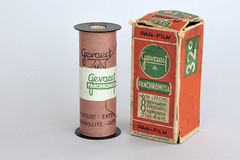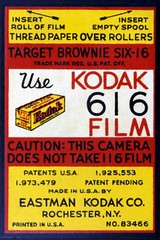Difference between revisions of "116 film"
Radiophoto (talk | contribs) (I removed dead links and added pages from my own site, plus a pertinent article written by me about camera conversion.) |
(clarity) |
||
| Line 9: | Line 9: | ||
|image_rights= with permission | |image_rights= with permission | ||
}}{{br}} | }}{{br}} | ||
| − | '''116''' is a [[roll film]] introduced by [[Kodak|Eastman Kodak]] in 1899 for 2½×4¼ inch negatives (nominally 6.5×11 cm)<!-- Is it an exact conversion? Or is it optimistic, as for 6x9? -->. The film stock is 70mm wide: wider than that of [[120 film]]. | + | '''116''' is a [[roll film]] introduced by [[Kodak|Eastman Kodak]] in 1899 for 2½×4¼ inch negatives (nominally 6.5×11 cm)<!-- Is it an exact conversion? Or is it optimistic, as for 6x9? -->.<ref name="kodaknumbers">Walker Mangum, "[http://www.nwmangum.com/Kodak/FilmHist.html History of Kodak roll film numbers]", at the [http://www.nwmangum.com/Kodak/ Kodak Collector's Page]. Mangum attributes this information to Thom Bell, writing in a website that no longer (2012) exists.</ref> The film stock is 70mm wide: wider than that of [[120 film]]. |
| − | In 1932, Kodak introduced '''616''' film. This has a slightly slimmer spool (originally metal rather than wood). [[Agfa]]/[[Ansco]] gave the 616 size their own designation '''PD16'''. Kodak discontinued both 116 and 616 in 1984. | + | In 1932, Kodak introduced '''616''' film.<ref name="kodaknumbers" /> This has a slightly slimmer spool (originally metal rather than wood). [[Agfa]]/[[Ansco]] gave the 616 size their own designation '''PD16'''. Kodak discontinued both 116 and 616 in 1984.<ref name="kodaknumbers" /> |
| − | With some ingenuity, 120 film can be used with cameras designed for 116 and 616, as can 70mm film. Remember that if you respool 120 film onto 116/616 spools and have it developed at a lab, you must ask for your 116/616 spools back | + | With some ingenuity, 120 film can be used with cameras designed for 116 and 616, as can 70mm film. (Remember that if you respool 120 film onto 116/616 spools and have it developed at a lab, you must ask for your 116/616 spools back or they'll be thrown away.) |
==Links== | ==Links== | ||
| Line 29: | Line 29: | ||
*[http://www.f6point3studio.com/agfa_ansco_captain/ Picture Gallery of Agfa-Ansco PD-16 Captain converted to shoot 120 film] at f/6.3 Studio | *[http://www.f6point3studio.com/agfa_ansco_captain/ Picture Gallery of Agfa-Ansco PD-16 Captain converted to shoot 120 film] at f/6.3 Studio | ||
*[http://greyhoundman.blogspot.com/2006_01_01_greyhoundman_archive.html 120 film in a 116 Brownie], by [http://greyhoundman.blogspot.com/ Greyhoundman] | *[http://greyhoundman.blogspot.com/2006_01_01_greyhoundman_archive.html 120 film in a 116 Brownie], by [http://greyhoundman.blogspot.com/ Greyhoundman] | ||
| − | |||
* [http://www.brownie-camera.com/film.shtml/ History of Kodak roll films] at the [http://www.brownie-camera.com/ Brownie Camera page] | * [http://www.brownie-camera.com/film.shtml/ History of Kodak roll films] at the [http://www.brownie-camera.com/ Brownie Camera page] | ||
*[http://www.realtime.net/~donday/photo/paper-lengths.html Kodak paper lengths by film type], by Don Day | *[http://www.realtime.net/~donday/photo/paper-lengths.html Kodak paper lengths by film type], by Don Day | ||
Revision as of 02:12, 3 February 2012
 
|
| Gevaert Panchromosa and Kodak Verichrome Pan film images by Dirk HR Spennemann (Image rights) |
116 is a roll film introduced by Eastman Kodak in 1899 for 2½×4¼ inch negatives (nominally 6.5×11 cm).[1] The film stock is 70mm wide: wider than that of 120 film.
In 1932, Kodak introduced 616 film.[1] This has a slightly slimmer spool (originally metal rather than wood). Agfa/Ansco gave the 616 size their own designation PD16. Kodak discontinued both 116 and 616 in 1984.[1]
With some ingenuity, 120 film can be used with cameras designed for 116 and 616, as can 70mm film. (Remember that if you respool 120 film onto 116/616 spools and have it developed at a lab, you must ask for your 116/616 spools back or they'll be thrown away.)
Links

|
| film type reminder in a Kodak camera image by Kenneth Dwain Harrelson (Image rights) |
- Convert Your 116/616 Box Camera to Shoot 120 Film, by Pete Lutz
- Picture Gallery of Agfa D-6 Shur-Shot converted to shoot 120 film at f/6.3 Studio
- Picture Gallery of Agfa PD-16 Clipper converted to shoot 120 film at f/6.3 Studio
- Picture Gallery of Agfa-Ansco PD-16 Captain converted to shoot 120 film at f/6.3 Studio
- 120 film in a 116 Brownie, by Greyhoundman
- History of Kodak roll films at the Brownie Camera page
- Kodak paper lengths by film type, by Don Day
- 116/616 film independence, by Don Day: On the use of 70mm film; introduces a supplier of packing paper
- Marking a 116/616 backing paper without a pattern, by Don Day
- Adapting a Patterson-type reel for large-format films, by Don Day